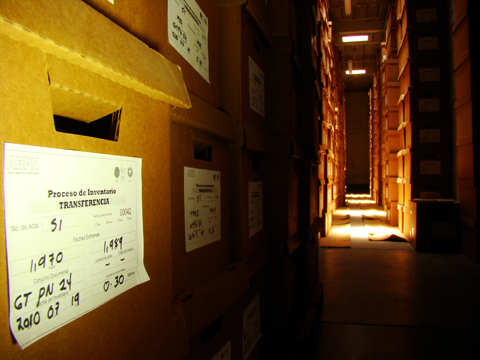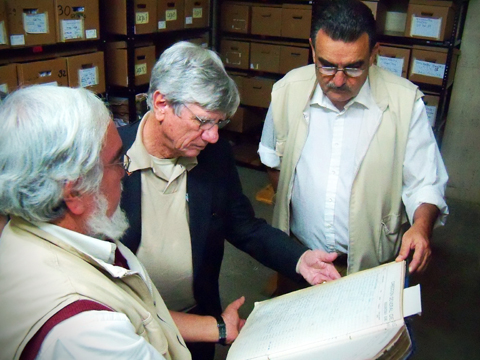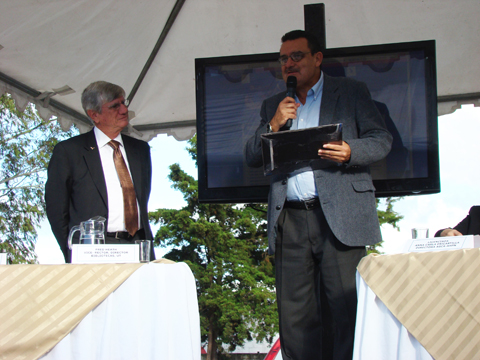
University of Texas Libraries Director Fred Heath traveled to Guatemala in December 2011 to participate in the launch of a joint project between the Guatemalan National Police Archive (AHPN) and The University of Texas at Austin. Together, AHPN and the Libraries would provide public access via the web to records of human rights violations by government agents that were discovered in a military munitions dump in 2004.
This is Dr. Heath’s travelogue of his trip.
Our flight to Guatemala City, 5,000 feet up in the Central American highlands took two and a half hours. Our destination was the National Police Archives, where on Friday we would celebrate with our colleagues, the recent opening of the AHPN website. I had yet to write my brief remarks.
In the cramped rear coach seat of the Boeing 737, I held my laptop in my lap, with the screen tilted slightly forward to accommodate the encroaching seatback of the traveler in front of me, and edited my three-minute talk. I was working from the draft I delivered the week before, when we first opened the web site of the Guatemalan National Police Archive.
Our next day — Friday, December 9 — would be International Human Rights Day, and AHPN director Gustavo Meoño had shrewdly decided to reciprocate the previous week’s events with a ceremony in Guatemala City celebrating the partnership between AHPN, administratively housed within the Ministry of Culture, and the University of Texas.
At 35,000 feet, I was not sure what to expect. I did know that Christian Kelleher (program coordinator for the Human Rights Documentation Initiative), Karen Engle (director of the Rapaport Center for Human Rights and Justice) and Daniel Brinks (professor and co-director of Rapaport) would all address the audience at AHPN, projected to be some 200 in number, but I knew little about the attendees. I also knew that all three of my colleagues would deliver their remarks in Spanish; so I was determined to keep my Anglo remarks brief. As I wrote, I wanted to answer the question of why democracies elect to archive and preserve even the dark chapters of their histories, rather than deny or erase them. I chose to use the example of the Lyndon Baines Johnson Library & Museum, whose holdings allow researchers to address the issues of the transfer of presidential power in the aftermath of the assassination of John Kennedy, to study an epochal period in our own tumultuous civil rights movement, and to inquire into the dark chapter that was the war in Vietnam. My hope was that in my brief remarks I could remind our Guatemalan audience that in a democracy it is necessary to study all parts of our past, in order to learn from our accomplishments, and avoid the recurrences of our missteps.
Upon landing, Christian and I cleared customs and were met at the gates by Jorge Villagran, IT chief at AHPN, who had played a major role in the presentation in Austin. He had been anxiously awaiting our arrival for an hour, and after a cordial handclasp, we tossed our baggage in his automobile and rapidly hurtled away toward the archive. It was to close at 4:30, giving us barely an hour for my first tour, and many staff were standing by to demonstrate their work in creating order out of chaos.

The neighborhood in which the archive was located, fully half an hour from the airport, is one of the city’s poorer, a mixture of small shops and dwellings of two and three stories. The compound itself is ringed by a rusting mound of derelict automobiles, long ago impounded by the police for a myriad of reasons not fully explained to us, and the entryway was casually guarded by an armed and uniformed contingent, who waved to Jorge and raised the barrier to provide us access. The police continue to occupy portions of the compound, but other than a pen for the canine corps, their presence was not dominatingly obvious.
Between the weed-choked ring of automobiles and the compound, a new fence had been erected, its inner wall decorated with human rights motifs painted by visiting delegations. Its gate was decorated with the handprints of the children of AHPN’s employees. The juxtaposition of so many incongruous elements required concentration to process.
Gustavo Meoño, director of the Historical Archive of the National Police, was there at the entry to greet us upon our arrival, an emotional reunion hastily concluded due to the lateness of the hour. AHPN occupies a vast labyrinth of concrete block rooms and corridors of various sizes. Six years ago, when the cache of police records were discovered, every available inch of the facility was crammed floor to ceiling with random packets of documents, tied with string, and piled randomly one upon the other. Often the strings burst, or fell away when severed by gnawing rodents. On occasion, entire stacks fell over and spilled their contents into the narrow corridors that served as footpaths among the moldering mounds of decaying documentation. Oppressive environmental conditions in a closed and abandoned building encouraged a mildew bloom that swept the collection, and colonies of bats, rats, mice and cockroaches took up residence and added the process of decay and disorder.
Gustavo had wisely kept one or two rooms opened to the courtyard, as they were upon discovery, in order to permit first-time visitors such as myself to better understand the magnitude of the challenge he and his team faced six years ago when they set out to begin their work on organizing the eighty million pages of documents that chronicled a century of police activity in Guatemala, including dark hours of repression, imprisonment for political beliefs, and carefully planned disappearances and assassinations. As hundreds have before, I ran my hand over some of the random stacks, scraped at the mildew, and photographed the handwritten labels on some of the bundles, “homicidas,” and “capturas.” A thought quickly formed in my mind that I would have never been able to conceive the plan of work that led to the AHPN website we had recently brought on line, nor the processing workflow that I was shortly to see inside.

Inside, on the day before the celebration and the ensuring month-long Christmas holiday, the entire AHPN team was still hard at work. Cadres, formed around police departmental record groups, had worked together for extended periods and had become familiar over time with the events, activities, and persons that might be significant in the document flow. Some were spending their time cleaning documents, capturing the most basic metadata, and housing the cleaned documents between acid-free sheets in stacks bound with linen ribbons. A handwritten notation on a cardboard cover sheets provides basic information on what is known about each record group.
Curators, like all other staff clad in street clothes and wearing a khaki vest with “AHPN” sewn onto the back, were busy processing the cleaned and organized documents. Two workers were at each of three sheet-fed scanners that also had a flat-bed option for more brittle documents. Years ago, when the effort began, there were six of these machines. Non-stop processing of two shifts a day for six years reduced their number to three, and active concern was shared about the need to procure replacements. In addition, two teams work at planetary scanners, large overhead installations designed to capture digital images of larger items, such as maps and books.
I did not ascertain the degree of completeness of the processing, but was able to glean a few impressions that I have filed away in memory as “facts.” On more than one occasion during the visit, I learned that the complete archive is estimated to contain some 80,000,000 pages. Of these, I believe a large proportion — perhaps more than half — have cleared the cleaning, re-organizing, basic metadata assignment stage. A directory of some 200,000+ names provides some access into the 10,000,000 documents that have been scanned, and into the larger corpus of processed documents that are available to visitors on site. About two years ago, AHPN — feeling that a sufficient mass had been achieved — opened the Guatemala archive to foot traffic. Some 6,000 Guatemalans have taken advantage of the opportunity.

After observing the process for some time, we were given a brief tour of various sectors of the building. In one area, boxes with yellow tags were stacked on pallets to considerable height, perhaps exceeding eight feet. Some were more properly housed on industrial shelving but far too few. In some instances, Coca-Cola plastic containers replaced oak pallets, and in far too many cases, stacks of cleaned boxes sat inelegantly upon flattened cardboard boxes. Opened sacks of calcium chloride served as the only desiccant, and a various deterrents were laid out strategically to battle the persistent pests, including as least one sack of garlic cloves designed to deter bats.
All too soon, my initial visit was over. Christian’s trained archival eye doubtlessly took in more, especially since it was his second tour of the faculty. A brief meeting with some of Gustavo’s senior staff including Ana Patricia Juárez concluded the day. Ana Patricia and Christian discussed some edits in AHPN website language and agreed on the need for closer collaboration between the Benson Archives and AHPN. The visit was cordial but lacked texture, giving me little reason to anticipate the substance-filled events that would occur over the next 24 hours.
…
Our Friday began at 7 AM. Christian and I set off in the first vehicle after breakfast, joined by Anna Carla, who helped direct our driver to our first destination — Universidad del Valle. The three of us met first with Luis R. Furlán, Director of the Computer Science Department and several other campus units. We squeezed into his tiny office and discussed ways in which the private university (founded in 1966) could aid AHPN.
We talked while a student assistant worked in the same cramped space, randomly sorting and re-sorting stacks of documents filed vertically in the office’s one bookcase. From Luis, we learned that Universidad del Valle was the Guatemalan node for RedCLARA, an initiative whose vision and purpose is to serve as a Latin American collaboration system by means of telecommunications … networks for research, innovation, and education. Luis assured us that he was familiar with AHPN and had spoken previous with its IT head Jorge about ways in which Universidad del Valle and AHPN could collaborate.
Looking at the sustainability of RedCLARA he indicated that the best way would be for AHPN to become a member. But at an annual cost of $1,700 month, he seemed to recognize that as an implausible route. Alternatively, he said, Universidad del Valle would likely be willing to accept the data drives heretofore hand carried to Austin, and transmit over the Internet 2 lines to UT. He intimated that European funders of RedCLARA were satisfied with the network the Latin American partners had built, but were eager to see content flowing across the infrastructure. The AHPN/UT partnership could provide that dataflow.
Subsequently, we moved upstairs to the conference room of Vice Rector Maria Luisa Durando de Boehm. We were joined there by the Vice Rector, Karen, Dan and Jorge. Over coffee, the Vice Rector spoke of a working relationship between Universidad del Valle and the University of Virginia, and warmly invited the exploration via a memorandum of understanding of a wider collaboration with the University of Texas. Luis then spoke of a particular collaboration among RedCLARA Latin American partners in the study of indigenous languages, and when we informed him of the availability of a large dataset of indigenous language materials (AILLA) on the UT Libraries servers that potentially could form a rich base for future collaborations, he and the Vice Rector indicated that could indeed be fertile ground for collaboration. We mentioned as well the availability of the doctoral dissertations of Texas’ larger universities — UT, Texas A&M, Texas Tech, etc. — via our servers and their interest continued to grow.

Later, we arrived at the conference site shortly before the scheduled start time of the unveiling of the AHPN website. The crowd, which would number around 200 at its height, was beginning to trickle in as we arrived for the nominal 2 PM start time. There we were greeted by Jan-Jaap Van De Velde, the Netherlands ambassador to Guatemala, and Michael Frühling, Sweden’s ambassador. They took time to emphasize how pleased they were that their funded developmental work at the AHPN would now be protected by UT’s readiness to host the website and preserve the database. With the digital instantiation on the web, there was little reason to be concerned about political risks to the physical archive. We also met other people, including Fredy Peccerelli, a forensic anthropologist and a founder of the Guatemalan Forensic Anthropology Foundation (FAFG) and whose work is portrayed in the film Granito, which was screened at our conference in Austin. Gustavo graciously presented the UT delegation with a plaque for our work at a point in the ceremony.
International Human Rights Day was also the last day of work for AHPN staff before the month-long holiday for most state workers, and at the end of our two-hour ceremony, they poured onto the grounds in anticipation of work’s end and the beginning of holiday. The tents which one moment housed the monitors featuring the newly accessible website and the seats of 200 attendees were instantly transformed into table settings for a like number of celebrants. The platform upon which we spoke was cleared and became the stage for the band whose handlers quickly assembled their amplifiers and sound systems. The performers were none other than the national police band — onstage and entertaining the AHPN staff in the unlikeliest of scenarios. This tableau at once reassuring and surreal was, not surprisingly, the brainchild of Gustavo, who seizes every occasion to affect rapprochement between the two sides. We ended the evening before our return home with enthusiastic dancing and general satisfaction at a successful beginning in what promises to be a long and mutually beneficial partnership. ![]()

One thought on “The Libraries Afield: Launching the Guatemalan National Police Archives Website”